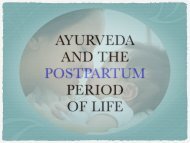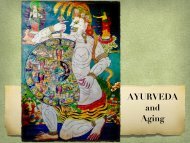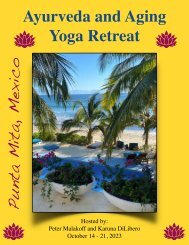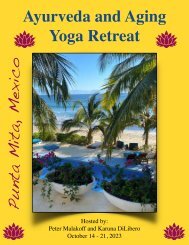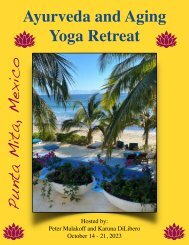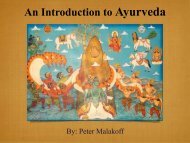Ayurveda and Aging
Shiryate Iti Shariram “The body is constantly going through the process of decay” The Universe resides in the body of Time or Kala and moves in a clockwise manner. Kala is the most important of qualities and utterly unavoidable. Kala is responsible for Aging and Old Age is considered by Ayurveda to be a disease born of Kala or Time. Buddha said: “Suffering is inevitable.” He also said that “All suffering is not necessary.” The ‘disease’ of Aging is inevitable but it may be manifested in a timely or untimely, comfortable or uncomfortable, disease-free or disease-filled manner. Herein lies the Ayurvedic approach to Aging . . . it is the Veda or science of Ayu or Life. It does not prevent death but prolongs life and health, offering useful insight and wisdom for how to live our elder years (from 50-60 on) in the best possible way. That is the subject of this short book illustrated with slides and stories from the Indo-Tibetan-Buddhist Tradition. This slideshow-flipbook was originally presented as the basis of a talk: Ayurveda and Aging, by the author in Tiruvannamalai, Tamil Nadu, India in the winter of 2017. Peter Malakoff petermalakoff@gmail.com www.petermalakoff.com
Shiryate Iti Shariram
“The body is constantly going through
the process of decay”
The Universe resides in the body of Time or Kala and moves in a clockwise manner. Kala is the most important of qualities and utterly unavoidable.
Kala is responsible for Aging and Old Age is considered by Ayurveda to be a disease born of Kala or Time.
Buddha said: “Suffering is inevitable.” He also said that “All suffering is not necessary.” The ‘disease’ of Aging is inevitable but it may be manifested in a timely or untimely, comfortable or uncomfortable, disease-free or disease-filled manner.
Herein lies the Ayurvedic approach to Aging . . . it is the Veda or science of Ayu or Life. It does not prevent death but prolongs life and health, offering useful insight and wisdom for how to live our elder years (from 50-60 on) in the best possible way. That is the subject of this short book illustrated with slides and stories from the Indo-Tibetan-Buddhist Tradition.
This slideshow-flipbook was originally presented as the basis of a talk: Ayurveda and Aging, by the author in Tiruvannamalai, Tamil Nadu, India in the winter of 2017.
Peter Malakoff
petermalakoff@gmail.com
www.petermalakoff.com
You also want an ePaper? Increase the reach of your titles
YUMPU automatically turns print PDFs into web optimized ePapers that Google loves.
AYURVEDA<br />
<strong>and</strong><br />
AGING
This is an<br />
Introduction to the Topic of <strong>Aging</strong><br />
considered from the point of view<br />
of <strong>Ayurveda</strong>.<br />
The slides presented here are like<br />
Sutras <strong>and</strong> meant to be<br />
commented on by a teacher.<br />
Even so, they may be of value
<strong>Ayurveda</strong> is the<br />
‘Veda’<br />
or ‘Science’<br />
of<br />
‘Ayu’ or ‘Life’
<strong>Ayurveda</strong><br />
is taught on<br />
earth so<br />
mankind can<br />
enjoy a long<br />
<strong>and</strong> healthy<br />
lifespan
<strong>Ayurveda</strong> contains<br />
the Vidya or knowledge<br />
of how to create or maintain<br />
the health of the healthy<br />
<strong>and</strong> cure or palliate the disease<br />
of a diseased person
From Sankhya <strong>and</strong> the Yoga Sutras,<br />
<strong>Ayurveda</strong> draws a fundamental principle<br />
regarding the Law of Karma:<br />
’Heyam Dukham Anagatam’<br />
- Patanjali Yoga Sutras 2:16<br />
‘The suffering that has not yet come<br />
can be avoided’
The suffering<br />
that is here,<br />
is here because of karmic reasons,<br />
it has cause(s)<br />
<strong>and</strong> must be endured
But the suffering<br />
that is not yet here can be avoided,<br />
by changing our actions<br />
The knowledge of <strong>Ayurveda</strong> says:<br />
with right underst<strong>and</strong>ing<br />
we may orient ourselves towards health<br />
by means of our actions
There is a causative factor for the<br />
manifestation of a being but there is no<br />
cause for the cessation of this manifestation<br />
since death following birth is the natural<br />
flow of life itself<br />
- Charaka Samhita
Suffering born of Time (<strong>Aging</strong>) is<br />
inherent in life <strong>and</strong> cannot be<br />
avoided, but only palliated.<br />
This is the consideration of<br />
<strong>Ayurveda</strong> <strong>and</strong> <strong>Aging</strong>
KALA<br />
(Time)
Life depends upon<br />
the power of<br />
Time or Kala<br />
<strong>and</strong><br />
Time is basic to our consideration<br />
when we are talking about:<br />
<strong>Aging</strong>
In <strong>Ayurveda</strong><br />
Old Age is a ‘disease’<br />
brought about by Time
It is written in the Ayurvedic<br />
texts:<br />
‘Shiryate Iti Shariram’<br />
‘The body is constantly decaying’
We know everyone<br />
who has taken birth<br />
must grow old <strong>and</strong> die,<br />
but no one wants to grow old<br />
<strong>and</strong> no one wants to die<br />
But even from conception the<br />
body is tending towards death
According to Buddha:<br />
Birth, Disease, Old Age <strong>and</strong> Death<br />
comprise the inevitable suffering<br />
of a human being
“. . . birth is suffering, old age is suffering,<br />
illness is suffering, union with unpleasant<br />
things is suffering, separation from<br />
pleasant things is suffering, not obtaining<br />
what we wish is suffering; all clinging to<br />
existence is suffering”<br />
- Buddha
Buddha was asked,<br />
‘How are you different than other<br />
men?’<br />
He replied:<br />
‘I was disturbed by<br />
Birth, Disease, Old Age <strong>and</strong> Death,<br />
others did not seem to be so disturbed’
Without realizing ‘suffering’ as<br />
the nature of existence,<br />
why else would one be<br />
truly interested in Liberation?
In <strong>Ayurveda</strong>,<br />
any state that is not pleasurable<br />
is called - ‘disease’<br />
In Tibetan medicine,<br />
(which arose out of <strong>Ayurveda</strong>),<br />
life itself is a disease that ends in death<br />
<strong>and</strong><br />
everyone has this disease!
In the highest teachings of the<br />
Vedic <strong>and</strong> Buddhist traditions<br />
Pain <strong>and</strong> pleasure, birth <strong>and</strong> death,<br />
youth <strong>and</strong> old age are inextricably<br />
tied together <strong>and</strong> we cannot know<br />
or experience one without the<br />
other
<strong>Ayurveda</strong> considers <strong>Aging</strong><br />
as: Yapya,<br />
a‘Natural’<br />
<strong>and</strong> only<br />
Palliatible disease
‘Palliative’ here means:<br />
Treatment that affirms life <strong>and</strong><br />
regards ‘aging,’ <strong>and</strong> death as a<br />
natural <strong>and</strong> normal process<br />
Palliative Care provides relief<br />
from unnecessary pain or<br />
distressing symptoms
Even though Buddha said:<br />
‘Suffering is inevitable’<br />
he also said that:<br />
‘All suffering is not necessary’
The disease of <strong>Aging</strong> is<br />
inevitable, but it may be<br />
manifested in a timely or<br />
untimely, comfortable or<br />
uncomfortable, disease-free or<br />
disease-filled manner
The Ayurvedic approach to <strong>Aging</strong>:<br />
‘Avoid the suffering<br />
that has not yet come’<br />
by remedying <strong>and</strong>/or palliating<br />
the underlying imbalances<br />
in the body brought about by <strong>Aging</strong>
Even though,<br />
Time or Kala creates an<br />
unavoidable imbalance in the<br />
body<br />
<strong>Ayurveda</strong> teaches how to<br />
palliate that ‘unavoidable’<br />
imbalance
The universe resides in the<br />
body of Time or Kala which<br />
moves in a ‘clockwise’ or<br />
sequential manner.<br />
Time is a fundamental quality<br />
of life <strong>and</strong> the most<br />
unavoidable quality<br />
of them all!
O my Lord! Oldness has come, old age has descended.<br />
Feebleness has arrived; dotage is here anew. The heart<br />
sleeps wearily every day. The eyes are weak, the ears are<br />
deaf, my strength is disappearing because of weariness<br />
of the heart <strong>and</strong> my mouth is silent <strong>and</strong> cannot speak.<br />
The heart is forgetful <strong>and</strong> cannot recall yesterday. My<br />
bones suffer old age. Good is become evil. All taste is<br />
gone. What old age does to men is evil in every respect.<br />
- Poem from Egypt, 4500 years ago
According to <strong>Ayurveda</strong>-<br />
The growth, development,<br />
maintenance <strong>and</strong> decay<br />
of the body<br />
are dependent on<br />
four factors or qualities:
1) Kala (time)<br />
2) Swabhava<br />
(nature, doshic make up)<br />
3) Ahar (Diet)<br />
4) Environmental factors
The first two:<br />
1) Kala (time)<br />
2) Swabhava<br />
(nature, doshic make up)<br />
We Cannot Control but only Palliate
The second two:<br />
3) Ahar (Diet)<br />
4) Environmental factors<br />
We Can Control
The second two qualities:<br />
(Diet-Ahar) <strong>and</strong> Environment)<br />
can be controlled by adjusting<br />
them according to<br />
what cannot be controlled:<br />
Kala- Time(impersonal)<br />
<strong>and</strong><br />
Svabhava- Self-Nature (personal)
Kala or Time is said to hold a<br />
human being<br />
in its grasp<br />
from birth until death
It is Kala or Time that creates:<br />
• The Yugas<br />
• The Seasons of a persons life<br />
• The Seasons of a year<br />
• The Hours of day <strong>and</strong> night
So fundamental is Kala or<br />
time that an image of Kala<br />
holding the wheel of life is<br />
painted directly next to the<br />
main entry of every Tibetan<br />
Buddhist monastery
It is called:<br />
the Bhavachakra<br />
or the<br />
The Wheel of Becoming<br />
or<br />
The Wheel of Life
Buddha created the Bhavachakra to<br />
illustrate man’s actions, the fruits of<br />
those actions, the different realms or<br />
places where those actions take place<br />
<strong>and</strong> how one action always leads to<br />
another; it is a picture of the always<br />
<strong>and</strong> only ‘co-dependently arising<br />
nature of this <strong>and</strong> all lifetimes’<br />
- Pratityasamutpada
Buddha depicted Time or Kala<br />
as a context,<br />
of inescapable suffering<br />
. . . for it is Time that determines<br />
our inability to gain permanent<br />
happiness in life no matter what<br />
our actions are
Many of the greatest spiritual Teachers<br />
speak about Time <strong>and</strong> Death as the<br />
the Reality of human life <strong>and</strong> said only<br />
those individuals who were aware of<br />
the inherent, suffering nature of the<br />
human condition - Dukkha, could<br />
truly orient<br />
towards spiritual practice
Just as we need to underst<strong>and</strong> the<br />
place where we live<br />
the Season of the year<br />
<strong>and</strong> the time of the day<br />
<strong>Ayurveda</strong> says it is necessary to<br />
underst<strong>and</strong><br />
\<br />
the Season or Time<br />
of our life
According to <strong>Ayurveda</strong>,<br />
Time is an inescapable factor<br />
or ‘disease’ of the body<br />
The effect of Time on the body<br />
is Kshaya or the diminishment<br />
of all the capabilities of the<br />
body-mind with old age
The Stages of Life
The Ch<strong>and</strong>ogya Upanishad says<br />
that a healthy man or woman<br />
enjoys 116 years of life<br />
Balavastya: +/- 24 years<br />
Yuvavastha: +/- 44yrs (24-68)<br />
Vrddhavastha: +/- 48 yrs (108-116)
Woman
Man
Balavastya (Youth)<br />
From conception to a girl’s first period<br />
(approximately 14-16 years of age; now<br />
earlier) is the time ruled by Kapha or<br />
the EARTH <strong>and</strong> WATER elements.<br />
This period exhibits a steady increase<br />
<strong>and</strong> coordination of the strength <strong>and</strong><br />
integrity of the body, mind <strong>and</strong> senses
Madhyavasta (Middle Age)<br />
Middle age is ruled by the FIRE element<br />
<strong>and</strong> lasts (approximately) from 14-16 years<br />
to 60-70 years of age. It is dominated by<br />
Pitta Dosha or the fire element. There is<br />
an increase of hormonal activity, digestive<br />
abilities of food <strong>and</strong> experience; full<br />
engagement of the senses, mind, intellect<br />
<strong>and</strong> a greater (or lesser) mastery of will
Vriddhavastha (Old Age)<br />
This is the period from 70 years to our<br />
death, when there is ever-increasing<br />
wasting or decay (Kshaya) in the body.<br />
This time of life correlates<br />
with Vata Dosha or the air <strong>and</strong> ether<br />
elements
In old age there is a natural decrease<br />
of the Dhatus or bodily tissues:<br />
There is wrinkling of the skin, graying<br />
of the hair, baldness, diminished<br />
ability to do physical work, diminished<br />
digestive power (Jatharagni) <strong>and</strong><br />
diminished immunity (Ojas)
In old age<br />
(even if one is not sick or in pain)<br />
there is a decrease in the Indriyas<br />
(sensory organs)<br />
There is diminishing strength,<br />
speech, mental <strong>and</strong> cognitive<br />
functions, memory, intellect <strong>and</strong><br />
analytic ability
When these symptoms come<br />
about in accord with Kala (time)<br />
<strong>and</strong> a balanced or healthy<br />
Swabhava (self-nature),<br />
it is known as<br />
Kalaja Vriddhavastha or<br />
(natural <strong>Aging</strong>)
When aging results from a result<br />
of a defective diet <strong>and</strong> lifestyle,<br />
Vriddhavastha (old age) begins<br />
earlier <strong>and</strong> is then known as<br />
Akalaja Vriddhavastha<br />
or (untimely aging) <strong>and</strong> is usually<br />
accompanied by disease
Worry, Anxiety, Smoking <strong>and</strong> <strong>Aging</strong><br />
produce Vata in any individual
<strong>Aging</strong> can be slowed <strong>and</strong><br />
untimely aging is preventable.<br />
Even if symptoms of untimely<br />
aging are already manifested,<br />
they can be managed or<br />
palliated by applying the<br />
principles of <strong>Ayurveda</strong>
The word for ‘Health’ in<br />
<strong>Ayurveda</strong> is Sama or balance<br />
<strong>and</strong> the working principle of<br />
<strong>Ayurveda</strong> regarding the<br />
elements is:<br />
‘Like increases Like<br />
Opposites decrease one another’
According to <strong>Ayurveda</strong>, the<br />
‘patho’-physiology of aging is<br />
caused primarily by diet <strong>and</strong> the<br />
process of <strong>Aging</strong> can be slowed<br />
by correcting <strong>and</strong> balancing<br />
the diet <strong>and</strong> lifestyle
A clear <strong>and</strong> comprehensive<br />
description of aging, its prevention<br />
<strong>and</strong> treatment have been laid out in<br />
the classical Ayurvedic texts.<br />
Aptopadesha (textual knowledge) is<br />
the first step on the path.<br />
Of course knowledge has to be<br />
put into practice<br />
to be effective.
SVABHAVA<br />
or<br />
Self nature
The second of the four factors<br />
(Kala, Svabhava, Diet, Environment)<br />
that create the growth, development,<br />
maintenance<br />
<strong>and</strong> decay of the body is‘Svabhava’<br />
or the unique, individual nature <strong>and</strong><br />
quality of our body
For most people in the west today<br />
who have gained a little knowledge of<br />
<strong>Ayurveda</strong>,<br />
Svabhava is another name<br />
for Dosha
To balance Svabhava it is<br />
necessary to underst<strong>and</strong> the<br />
‘5 elements,’ as our ‘unique’<br />
body is composed of<br />
differing combinations of<br />
what are called the<br />
5 elements or the<br />
Panchamahabhutas
These five elements are:<br />
Ether (Akash)<br />
Air (Vayu)<br />
Fire (Agni or Tejas)<br />
Water ( Jala)<br />
Earth (Bhumi)
The Five Elements<br />
Panchamahabhutas
Everything in creation is made of<br />
differing combinations of<br />
the 5 elements<br />
(always <strong>and</strong> only<br />
all-together appearing)<br />
or what are called the<br />
Panchamahabhutas
When the<br />
Panchamahabhutas are<br />
considered in terms of location<br />
they are called: the Environment:<br />
desert, ocean, forest, mountain,<br />
cold, hot, windy, dry
When the<br />
Panchamahabhutas are<br />
considered in terms of Food<br />
they are called- The Six tastes:<br />
sweet, sour, salty, bitter,<br />
pungent, astringent
When the<br />
Panchamahabhutas are<br />
considered in terms of the<br />
Seasons of the year, they are<br />
called:<br />
spring, summer, fall, winter
When the<br />
Panchamahabhutas are<br />
considered in terms of the<br />
Time of the day, they are called:<br />
dawn, morning, afternoon,<br />
evening <strong>and</strong> nighttime
When the<br />
Panchamahabhutas are<br />
considered in terms of the<br />
Seasons of a persons life, they are<br />
called: childhood, adolescence,<br />
middle age <strong>and</strong> old age
When the<br />
Panchamahabhutas are considered in terms of<br />
the 5 Shiva Temples (Panchabootasthalams) of<br />
South India they are called:<br />
Earth: Ekambareshwara Temple, Kanchipuram<br />
Water: Jambukeshwara, Trichy<br />
Fire: Annamalaiyar Temple, Tiruvannamalai<br />
Air: Srikalahasteeswara Temple, Srikalahasti<br />
Ether: Tillai Nataraja Temple, Chidambaram
When the<br />
Panchamahabhutas are<br />
considered in terms of the<br />
Ages of the Universe they are<br />
called the Yugas:<br />
Kali, Dwarpa, Treta <strong>and</strong> Sat
When the Panchamahabhutas<br />
are considered in terms of the<br />
human body they are called:<br />
Doshas
Doshas<br />
Panchamahabhutas<br />
<strong>and</strong><br />
Dosha
“Neither in theory nor in fact is<br />
there a physical manifestation<br />
that cannot be accounted for<br />
by the concept of Tridosha”<br />
– Caraka Samhita
The ‘’Nature’ or quality<br />
of a thing<br />
(or one’s body)<br />
is called:<br />
DOSHA<br />
or<br />
SVABHAVA
When we consider<br />
the individual being<br />
<strong>and</strong> his or her unique combination<br />
of the elements<br />
the particular element (or elements)<br />
that predominates amongst them<br />
is called their Dosha
DOSHA<br />
(Also) Means that which vitiates,<br />
aggravates, darkens, spoils<br />
or<br />
causes things to decay
Varying combinations of the<br />
Panchamahabhutas or 5<br />
Elements comprise the<br />
Doshas
Vata, Pita <strong>and</strong> Kapha<br />
are the 3 Doshas
Let’s look at Dosha <strong>and</strong> how<br />
differing combinations of the<br />
elements determine the<br />
different types of the human<br />
body-mind:
KAPHA
PITTA
VATA
Kapha <strong>and</strong> Vata
‘Yatha Loka Tatha Pindam’<br />
The physical <strong>and</strong> psychological human being<br />
follows the pattern of a full day of the world<br />
Kapha in the morning hours (6-10am)<br />
Pitta in the midday hours (10-2pm)<br />
Vata in the late afternoon hours (2-6pm)
Kapha rules the morning hours (6-10am)<br />
Diseases of a Kapha type mainly happen<br />
to a person in their Kapha season of life<br />
<strong>and</strong> their symptoms express most<br />
powerfully during the Kapha hours
Pitta rules the midday hours (10-2pm)<br />
Adolescence-Midlife (14-60yrs)<br />
Middle age people are primarily affected<br />
by Pitta disorders <strong>and</strong> these symptoms often<br />
heighten during the Pitta hours of the day <strong>and</strong><br />
years of life
Vata rules the afternoon hours of the day (2-6pm)<br />
<strong>and</strong> the later years of life (70- death)<br />
Elderly people are primarily affected<br />
by Vata disorders <strong>and</strong> these symptoms<br />
often heighten during the Vata hours of<br />
the day <strong>and</strong> years of life
The 5 Elements or<br />
Panchamahabhutas express<br />
themselves<br />
in every aspect of life
Under the controlling effect<br />
of Time<br />
each Stage of life expresses<br />
different Panchamahabhutas<br />
or Doshas
Old Age<br />
The Season<br />
of<br />
Vata
Vata is the ‘environment,’ time or season<br />
of Old age<br />
Vata rules Old age<br />
Therefore,<br />
We must recognize, underst<strong>and</strong> <strong>and</strong><br />
balance the increase of Vata<br />
in our diet <strong>and</strong> lifestyle<br />
to maintain or create balance<br />
in our elderly years
Interestingly, our modern day environment<br />
is more Vata than ever before in history.<br />
We move faster,<br />
do more at any single moment,<br />
process our foods <strong>and</strong> drinks<br />
use modern medicine to suppress our<br />
disease symptoms<br />
spend more time in front<br />
of computers <strong>and</strong> TV<br />
Movies ‘move’ faster<br />
girls get their periods at a younger age
What are the qualities of Vata<br />
according to <strong>Ayurveda</strong>?:
Vata is:<br />
Cold<br />
Dry<br />
Light<br />
Irregular<br />
Rough<br />
Moving<br />
Quick<br />
Changeable<br />
Sharp
The Principle of how to achieve<br />
Balance or Sama in <strong>Ayurveda</strong> is:<br />
‘Similars increase one another’<br />
'Opposites decrease one another’
So, to balance Vata<br />
we need:<br />
Cold-<br />
Light -<br />
Dry -<br />
Irregular -<br />
Rough -<br />
Quick-<br />
Mobile-<br />
Subtle-<br />
Warm/hot<br />
Heavy<br />
Oily/ moist<br />
Regularity<br />
Smooth<br />
Slow<br />
Steady<br />
Touch
When Vata Dosha is out of<br />
balance there is an excess of the<br />
qualities that define that Dosha<br />
For instance:
Light: The person loses weight<br />
Cold: The person feels chilled<br />
Dry: The skin, lips, mucosal gl<strong>and</strong>s become dry<br />
Mobile: the voice becomes too quick or rambles<br />
Subtle: The person is easily affected by the<br />
feelings of others<br />
Hard: the stools become hard <strong>and</strong> difficult to<br />
eliminate<br />
Irregular: Easy to change<br />
Rough: The skin becomes rough
<strong>Ayurveda</strong> offers the knowledge of how<br />
to bring<br />
Vata Dosha into balance.<br />
The principle of how to achieve Balance<br />
is by increasing<br />
the opposite qualities:
Change needs to be made in<br />
Daily Routine, Sleep, Sex, Diet,<br />
Herbal supplements, colors,<br />
aromas, massage, oils <strong>and</strong><br />
overall lifestyle
Through adopting an<br />
appropriate diet <strong>and</strong> lifestyle<br />
can we bring<br />
Vata Dosha into balance
I tell people who have high Vata<br />
that like every other Dosha, they<br />
have been given both a blessing<br />
<strong>and</strong> a curse.<br />
‘The blessing is that it is easy for<br />
them to change; the curse is that<br />
it is easy for them to change.’
Whatever is done must be<br />
done steadily or regularly!<br />
Vata tends to be irregular <strong>and</strong><br />
irregularity only increases<br />
Vata Dosha
Here is more of what<br />
<strong>Ayurveda</strong><br />
says about<br />
Vata:
Physical Characteristics:<br />
Those with a predominance of Vata dosha<br />
usually have a thin, light frame <strong>and</strong> excellent<br />
agility. Their energy comes in bursts <strong>and</strong> they<br />
are likely to experience sudden bouts of<br />
fatigue. Vatas typically have dry skin <strong>and</strong> hair<br />
<strong>and</strong> cold h<strong>and</strong>s <strong>and</strong> feet. They sleep lightly<br />
<strong>and</strong> their digestion can be sensitive. When<br />
Vata dosha becomes imbalanced, it manifests<br />
in the body as weight loss, constipation,<br />
hypertension, arthritis, weakness,<br />
restlessness, <strong>and</strong> digestive challenges.
Emotional Characteristics:<br />
Vatas love excitement <strong>and</strong> new experiences.<br />
They are quick to anger but also quick to<br />
forgive. When Vatas are in balance, they are<br />
energetic, creative, <strong>and</strong> flexible. They also take<br />
initiative <strong>and</strong> are lively conversationalists.<br />
When unbalanced, they are prone to worry<br />
<strong>and</strong> anxiety <strong>and</strong> often suffer from insomnia.<br />
When they feel overwhelmed or stressed,<br />
their response is, “What did I do wrong?”
If excessive stress in your life leads to your<br />
Vata force becoming imbalanced, your activity<br />
will start to feel out of control. Your mind may<br />
race, contributing to anxiety <strong>and</strong> insomnia. You<br />
may start skipping meals, resulting in<br />
unintended weight loss, <strong>and</strong> your digestion<br />
may become irregular. If you notice these early<br />
symptoms of a Vata imbalance, slow down,<br />
take time to meditate, don’t skip meals, <strong>and</strong> get<br />
to bed earlier. A regular lifestyle routine helps<br />
ground Vata so you’re not<br />
carried away into the ether
Vata Pacifying Diet<br />
Vata is balanced by a diet of freshly cooked,<br />
whole foods that are soft or mushy in texture,<br />
rich in protein <strong>and</strong> fat, seasoned with a variety<br />
of warming spices, <strong>and</strong> served warm or hot.<br />
These foods calm vata by lubricating <strong>and</strong><br />
nourishing the tissues, preserving moisture,<br />
<strong>and</strong> maintaining warmth while supporting<br />
proper digestion <strong>and</strong> elimination.
Qualities to Favor <strong>and</strong> Avoid<br />
Vata is cool, dry, rough <strong>and</strong> light, so eating<br />
foods that neutralize these qualities – foods<br />
that are warm, moist, oily, smooth, <strong>and</strong><br />
nourishing – can help to balance excess Vata.<br />
An improved underst<strong>and</strong>ing of these qualities<br />
can guide you in making specific dietary<br />
choices that will better support Vata.
Tastes to emphasize:<br />
Sweet<br />
Sour<br />
Salty
Tastes to Decrease:<br />
Bitter<br />
Pungent<br />
Astringent
All six tastes should be eaten<br />
in every meal or cravings will<br />
develop!<br />
Of course there is a different<br />
proportion of tastes/elements<br />
for different dosas
Root vegetables <strong>and</strong> winter squash will<br />
help nourish <strong>and</strong> balance the body. Try<br />
carrots, beets, sweet potatoes,<br />
pumpkin, acorn, butternut, delicata,<br />
<strong>and</strong> buttercup squashes. These have<br />
the qualities of sweet, heavy, smooth,<br />
dense, <strong>and</strong> moist <strong>and</strong> are most<br />
balancing for Vata.
Casseroles<br />
Soups (Mung Dal)<br />
Stews
Grains<br />
Sweet grains such as basmati rice,<br />
wheat berries, brown rice, <strong>and</strong> sushi<br />
rice. Also, whole wheat pasta <strong>and</strong> or<br />
buckwheat udon noodles can be<br />
especially grounding for vata. Always<br />
include ghee <strong>and</strong> other healthful oils<br />
such as almond, sesame, or sunflower<br />
for internal oleation, kindling agni,<br />
<strong>and</strong> increasing absorption.
Spices<br />
When preparing food, use warming<br />
spices such as black pepper, dry<br />
ginger, cinnamon <strong>and</strong> asafoetida to<br />
help to stoke the digestive fire.
Lunch<br />
is the largest meal of the day<br />
Do not skip meals!
Drink Ginger Tea!<br />
Fennel<br />
Licorice
Stay Warm!<br />
Don’t get chilled<br />
Avoid Drafts <strong>and</strong> Wind
Avoid Raw Foods<br />
No cold drinks<br />
No caffeinated drinks<br />
No snack bars<br />
No Granola<br />
No Dried Fruits
OILS<br />
All good Fats<br />
Ghee<br />
Sesame oil<br />
Sunflower
Herbs<br />
Vata Digest Tablets from<br />
Banyan Botanicals<br />
Vata Churna from MAPI<br />
Haritaki- best for balancing Vata
Abhyanga or Oil Massage<br />
Coconut oil in hot climates<br />
Sesame oil in cooler climates
Vata<br />
(air <strong>and</strong> ether)<br />
is easily shaped by<br />
<strong>and</strong> even<br />
becomes their<br />
environment
Meditation<br />
Transcendental<br />
Meditation
Yoga Asana<br />
Knee to Chest Pose<br />
Do any <strong>and</strong> all asanas<br />
smoothly <strong>and</strong> lightly
Pranayama<br />
Nadi Shuddhi
Sleep<br />
Hot Milk with ginger, cinnamon<br />
<strong>and</strong> cardamom <strong>and</strong> saffron<br />
before bed<br />
Go to bed by 10am!
Rasayana<br />
The way of Rejuvenation
Rasayanas are herbal <strong>and</strong> mineral compounds<br />
which according to Vedic texts help to:<br />
- Maintain the original orderliness<br />
of the physiology<br />
- Preserve youthfulness <strong>and</strong> slow down<br />
or reverse the aging process<br />
- Strengthen the immune system<br />
- Make the body-mind more resistant<br />
to damaging influences
Rasayanas<br />
An 11th century Persian chemist <strong>and</strong> physician<br />
named Abu Rayhan Biruni reported about India:<br />
“They have a science similar to alchemy which is<br />
quite peculiar to them. They call it Rasayana. It<br />
means an art that is comprised of certain<br />
actions, herbs <strong>and</strong> compounds, most of which<br />
are taken from plants. It restores the health of<br />
those who were ill beyond hope <strong>and</strong> gives back<br />
youth to those fading in old age.”
It was said by my Teacher<br />
that of all the Rasayanas,<br />
the very best<br />
is to have a purpose in life<br />
that you are devoted to
Chyvana Rishi<br />
<strong>and</strong><br />
Chyvanaprash
Chyvanaprash
Amalaki<br />
“Of all Rasayanas, Amalaki is revered as one<br />
of the most potent <strong>and</strong> nourishing.<br />
“Amalaki is the best amongst rejuvenating<br />
herbs.”<br />
- Charak Sahita
‘Rasayana’ refers not merely to a<br />
herbal regimen (drug) or a<br />
therapy although both may be<br />
included.<br />
It is a ‘lifestyle’ that can be<br />
undertaken by anyone
Rasayana is for maintaining the<br />
health of healthy individuals as<br />
well as restoring the health of<br />
diseased individuals
Rasayana prolongs longevity,<br />
develops good health,<br />
improves mental faculties <strong>and</strong><br />
provides immunity against<br />
disease
There is a particular Rasayana called<br />
Kuti Rasayana<br />
When practiced it brings about<br />
Kaya Kalpa<br />
or the rejuvenation of the human<br />
body, skin, new teeth,<br />
regrowth of hair
The most famous practitioner of this<br />
was Tapasviji Maharaj who lived for<br />
185 years.<br />
There is a book written about him<br />
called: Maharaj
Sadvritta<br />
Sattvic Lifestyle<br />
Righteous living<br />
Good conduct<br />
Service<br />
Love
“Death is utterly acceptable to consciousness <strong>and</strong> life.<br />
There has been endless time of numberless deaths, but<br />
neither consciousness nor life has ceased to arise. The felt<br />
quality <strong>and</strong> cycle to death has not modified the fragility of<br />
flowers, even the flowers within the human body.<br />
Therefore, one's underst<strong>and</strong>ing of consciousness <strong>and</strong> life<br />
must be turned to that utter, inclusive quality, that clarity<br />
<strong>and</strong> wisdom, that power <strong>and</strong> untouchable gracefulness<br />
this evidence suggests. We must cease to live in our<br />
superficial <strong>and</strong> divided way, seeking <strong>and</strong> dem<strong>and</strong>ing only<br />
consciousness <strong>and</strong> life in the present form we grasp,<br />
avoiding <strong>and</strong> resisting what appears to be the end of<br />
consciousness <strong>and</strong> life in death.”<br />
- Adi Da Samraj
Benaras<br />
“A World in Which All things are Burning”
I present this topic-<br />
<strong>Ayurveda</strong> <strong>and</strong> <strong>Aging</strong><br />
an<br />
Introduction to <strong>Ayurveda</strong> <strong>and</strong><br />
many other courses<br />
Contact me at:<br />
email: petermalakoff@gmail.com<br />
Website: www.petermalakoff.com





